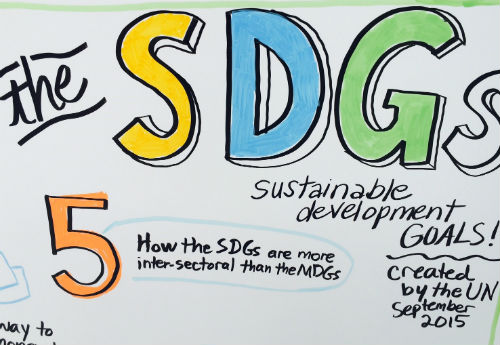At the fourth global Women Deliver conference in Copenhagen this week, media trainers from Thomson Reuters Foundation prompted reporters on how to build intrigue and interest around the United Nations Sustainable Development Goals. (I was one of the lucky reporters selected to attend.) The SDGs, which world leaders adopted as the 2030 Agenda for Sustainable Development in September 2015, include a set of 17 goals to end poverty, fight inequality and injustice, and tackle climate change—all by 2030. But while the goals seem noble and fascinating, readers suffer disaster fatigue and many think any issues the SDGs tackle exist only far away. This blog outlines suggestions to make the goals relatable (and memorable) for your reader:
Explain the magnitude
Ensure your readers grasp from your lede that the SDGs, which replaced the U.N.’s Millennium Development Goals, constitute the biggest environmental plan the world has ever seen. In a meeting, UN Special Advisor David Nabarro, called the plan “the largest of its kind—an ambitious and inspiring political manifesto that provides a global framework for people, planet, prosperity, partnership and peace for the next 15 years,” he said. “There is no plan B; this is the plan.” And to avoid readers thinking the SDGs aren’t a local issue, consider a UN DESA undersecretary-general who once said if we all lived like people in developed countries do, we’d need three or four different globes to support the demand for natural resources. These kind of quotes and sentiment help put the SDG’s into context showing what’s at stake and why your readers should care.
Break the goals up into digestible chunks
Seventeen goals–including eradicating hunger, inequality and gender equality–contain specific targets (169 precisely) for governments to collectively reach over the next 15 years. Rather than list the targets, read the details, carefully striping away the jargon and look for story ideas within. For instance, Goal 5, achieving gender equality and empowering all women and girls, cites targets including:
- Eliminate all forms of violence against all women and girls, including trafficking and sexual and other types of exploitation.
- Recognize and value unpaid care and domestic work through the provision of public services, infrastructure and social protection policies. Promote shared responsibility within the household and the family as nationally appropriate.
- Undertake reforms to give women equal rights to economic resources, as well as access to ownership and control over land.
Show your readers the goals are inter-connected, with targets like achieving full employment for all (Goal 8), and doubling how much small-scale farmers, many of whom are women, produce and earn (Goal 2).
Look for news hooks to push the story forward
On that same note, look for fresh news in which to frame the goals. For example, Melinda Gates and the Gates Foundation announced at Women Deliver their $80 million pledge to improve gender data to help generate information on gender disparities, such as unpaid work and asset ownership. Because most experts agree that achieving gender equality (Goal 5), ties to all 17 SDGs, and that if we want a baseline around gender equality, we must expand our data, suddenly this pledge becomes big news.
Make the stories relatable
We must also remain good storytellers. At the Women Deliver conference, experts frequently describe journalists as the crusaders who can take the reader to the numbers, the development goals, then back to the face of those impacted. Some ideas follow:
- Profile the world thinkers, physicians, obstetricians and activists pushing the SDGs forward. Who inspired them and what motivates (and worries) them today?
- Listen for those powerful and emotive quotes. One medical expert shared that his work was inspired by the grief he felt when women, with complications in their delivery, came to him in a perilous state and died in his arms. Now he’s committed to ensuring birth support exists in birth centers throughout the developing world. In talking about the importance and need for SDGs, Nabarro, the UN advisor, said memorably, “If people don’t have food and shelter, they are more likely to use force to get what they want.”
- Profile businesses, the stories behind the ventures designing products to improve water quality to drive forward the need for (Goal 6) ensuring the availability and sustainable management of water and sanitation. Highlight the partnership of big businesses, such as Unilever, which Nabarro cited as the poster child of a business incorporating the SDGs in their business plan.
Find the business angles
Consider the following World Health Organization statistics:
- In 2015, over 300,000 women died in pregnancy or childbirth
- An estimated 225 million women have an unmet need for family planning.
- Suicide is the leading cause of death for adolescent girls aged 15-19, yet adolescent-friendly health services, including mental health services, are often available.
All this data, and other latest WHO data, which for health topics can be found at this link, provides fodder for rich, investigative stories (or localized stories) on the SDGs and their goals to improve equality, safety and life expectancy the world over.











